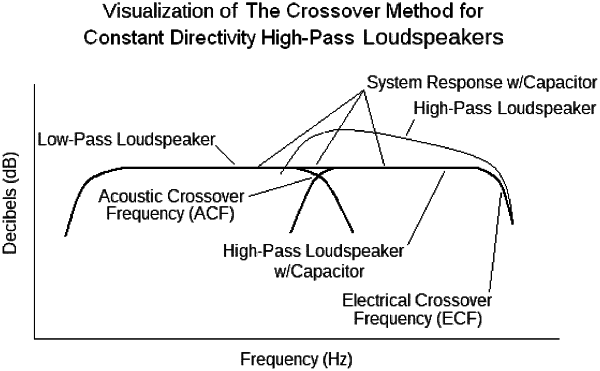| CPC H04R 3/14 (2013.01) [H04R 3/04 (2013.01); H04R 29/001 (2013.01); H04R 2430/20 (2013.01)] | 23 Claims |

|
1. A method comprising:
selecting a low-pass loudspeaker and a constant directivity high-pass loudspeaker that have complementary frequency ranges with little overlap in which said high-pass loudspeaker has sensitivity at its maximum usable frequency that approximates that of said low-pass loudspeaker and higher sensitivity than that of said low-pass loudspeaker at the low-pass loudspeaker's high frequency roll-off frequency attributable to the constant directivity highpass loudspeaker design having sensitivity inversely related to frequency;
determining a usable frequency range of said high-pass loudspeaker;
determining the impedance vs. frequency response of said high-pass loudspeaker or, if impedance vs. frequency response data is not available, its specified nominal impedance;
determining the capacitance of a passive capacitive loudspeaker system crossover comprising one or more non-polarized capacitors that provide capacitive reactance that equals the impedance of said high-pass loudspeaker at an electrical crossover frequency that approximates a highest usable frequency of said high-pass loudspeaker;
determining a usable frequency range of said low-pass loudspeaker;
determining the impedance vs frequency response of said low-pass loudspeaker or, if impedance vs. frequency response data is not available, its specified nominal impedance;
determining the combined frequency response and acoustic crossover frequency of said low-pass loudspeaker and a high-pass loudspeaker system comprising said crossover wired in series with said high-pass loudspeaker, said low-pass loudspeaker and said system constitute a parallel audio signal circuit, whereby said acoustic crossover frequency is the audio frequency at which said loudspeakers produce equal axial sound pressure, and in which said combined frequency response is passively equalized.
|